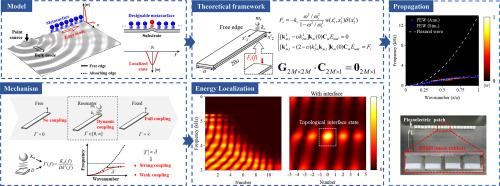通过深亚波长超表面的弯曲边缘波的能量局域化
IF 9.4
1区 工程技术
Q1 ENGINEERING, MECHANICAL
International Journal of Mechanical Sciences
Pub Date : 2025-09-10
DOI:10.1016/j.ijmecsci.2025.110821
引用次数: 0
摘要
对具有小尺寸结构的大波长弹性波的操纵一直是弹性动力学领域的一个长期目标。弹性超表面在亚波长范围内提供了一个很有前途的解决方案,通过引入局部共振,有可能扩展到深亚波长范围。在这里,我们提出了一种由一簇质量弹簧谐振器组成的深亚波长超表面(DSMS),并实现了弯曲边缘波(FEWs)的增强制导和能量局域化。谐振器的局部共振提供了谐振器与衬底之间的强耦合,从而导致弯曲波的引导,即导模。从动刚度角度看,导模产生于谐振腔附近区域的弱等效刚度:耦合较强,等效刚度较弱。在此基础上,设计了彩虹反射和拓扑界面态两种准周期dsss来实现不同的FEWs放大。这种放大可以通过简单地在平板上构建一个一维阵列来实现,而不需要像传统的超材料那样构造整个平板。我们的工作扩展了弹性超表面的概念和设计方法,为控制弹性薄板的能量分布提供了新的途径,在能量收集和声学器件开发中具有广泛的应用前景。本文章由计算机程序翻译,如有差异,请以英文原文为准。

Energy localizations of flexural edge waves via deep-subwavelength metasurfaces
The manipulation of elastic waves of large wavelengths with a structure of small size has been a long-standing objective in the field of elastodynamics. Elastic metasurfaces offer a promising solution in the subwavelength range, with the potential for extension to the deep subwavelength range through the introduction of local resonances. Here, we present a kind of deep-subwavelength metasurface (DSMS), which is comprised of a cluster of mass-spring resonators, and achieve enhanced guidance and energy localization of flexural edge waves (FEWs). The local resonance of the resonators provides a strong coupling between resonators and a substrate, which leads to the guidance of flexural waves, that is, guided modes. From the point of view of dynamic stiffness, the guided modes emerge from the weak equivalent stiffness of area near the resonators: stronger coupling weaker equivalent stiffness. On the basis of these, we design two quasi-periodic DSMSs to realize different amplification of FEWs: rainbow reflection and topological interface state. This amplification can be achieved by simply constructing a one-dimensional array on a plate without structuring the entire plate like conventional metamaterials. Our work extends the concept and the design method of elastic metasurfaces and provides a new route to manipulate the energy distribution in an elastic thin plate, which may exhibit wide applications in energy harvesting and acoustic device development.
求助全文
通过发布文献求助,成功后即可免费获取论文全文。
去求助
来源期刊

International Journal of Mechanical Sciences
工程技术-工程:机械
CiteScore
12.80
自引率
17.80%
发文量
769
审稿时长
19 days
期刊介绍:
The International Journal of Mechanical Sciences (IJMS) serves as a global platform for the publication and dissemination of original research that contributes to a deeper scientific understanding of the fundamental disciplines within mechanical, civil, and material engineering.
The primary focus of IJMS is to showcase innovative and ground-breaking work that utilizes analytical and computational modeling techniques, such as Finite Element Method (FEM), Boundary Element Method (BEM), and mesh-free methods, among others. These modeling methods are applied to diverse fields including rigid-body mechanics (e.g., dynamics, vibration, stability), structural mechanics, metal forming, advanced materials (e.g., metals, composites, cellular, smart) behavior and applications, impact mechanics, strain localization, and other nonlinear effects (e.g., large deflections, plasticity, fracture).
Additionally, IJMS covers the realms of fluid mechanics (both external and internal flows), tribology, thermodynamics, and materials processing. These subjects collectively form the core of the journal's content.
In summary, IJMS provides a prestigious platform for researchers to present their original contributions, shedding light on analytical and computational modeling methods in various areas of mechanical engineering, as well as exploring the behavior and application of advanced materials, fluid mechanics, thermodynamics, and materials processing.
 求助内容:
求助内容: 应助结果提醒方式:
应助结果提醒方式:


